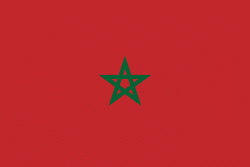Midelt
Midelt (Berber language: ⵎⵉⴷⴻⵍⵜ, Arabic: ميدلت) is a town in Morocco, in the high plains between the Middle Atlas and High Atlas mountain ranges. With a population of 55,304 recorded in the 2014 Moroccan census, Midelt serves as the commercial center of a large agricultural hinterland. It is also one of Morocco's principal cities for the mining of several minerals.
Midelt is situated on the main road between Fes and Meknes to the north and Errachidia to the south. Geographically, it is situated in the high plains surrounding the Moulouya River, between the Middle and High Atlas mountain ranges.
The city's elevation is 1508 m, making it one of the highest large towns in Morocco.
Midelt is situated on the main road between Fes and Meknes to the north and Errachidia to the south. Geographically, it is situated in the high plains surrounding the Moulouya River, between the Middle and High Atlas mountain ranges.
The city's elevation is 1508 m, making it one of the highest large towns in Morocco.
Map - Midelt
Map
Country - Morocco
 |
 |
| Flag of Morocco | |
In a region inhabited since the Paleolithic era over 300,000 years ago, the first Moroccan state was established by Idris I in 788. It was subsequently ruled by a series of independent dynasties, reaching its zenith as a regional power in the 11th and 12th centuries, under the Almoravid and Almohad dynasties, when it controlled most of the Iberian Peninsula and the Maghreb. In the 15th and 16th centuries, Morocco faced external threats to its sovereignty, with Portugal seizing some territory and the Ottoman Empire encroaching from the east. The Marinid and Saadi dynasties otherwise resisted foreign domination, and Morocco was the only North African nation to escape Ottoman dominion. The 'Alawi dynasty, which rules the country to this day, seized power in 1631, and over the next two centuries expanded diplomatic and commercial relations with the Western world. Morocco's strategic location near the mouth of the Mediterranean drew renewed European interest; in 1912, France and Spain divided the country into respective protectorates, reserving an international zone in Tangier. Following intermittent riots and revolts against colonial rule, in 1956, Morocco regained its independence and reunified.
Currency / Language
| ISO | Currency | Symbol | Significant figures |
|---|---|---|---|
| MAD | Moroccan dirham | د م. | 2 |
| ISO | Language |
|---|---|
| AR | Arabic language |
| FR | French language |















